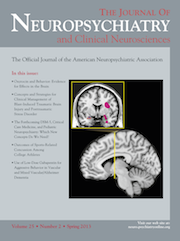Psychosis in a Female Patient With Tuberous Sclerosis
To the Editor: The characteristic triad of tuberous sclerosis (TUS) includes facial adenoma sebaceum, epilepsy, and mental retardation.1 However, the disease may have variable presentations, with neuropsychiatric symptoms, cardiac lesions, dermatological, and renal manifestations.2 Although TUS cases with psychosis, Capgras, and schizophrenia-like symptomatology3,4 have been reported, the knowledge about TUS connected with psychiatric disorders in literature is limited.
Case Report
“Ms. BB” was a 28-year-old divorced, illiterate woman with two children. She was hospitalized because of aggressive behaviors, insomnia, noncompliance with treatment regimen, a delusion of being married to a famous person, and running away from home. At her mental examination, she was irritable. Paranoid, reference, erotomanic, persecutive, and somatic delusions were detected. She had a Capgras delusion that another man had replaced her grandfather. No hallucinations were detected. There was decreased attention and inefficient abstraction; man/location orientation were intact, but time was disoriented. Adenoma sebaceum lesions around her nose wings were present at her physical examination. Her mother and daughter also suffered from TUS.
Parenteral haloperidol 20 mg/daily, biperiden 10 mg/daily, and quetiapine 600 mg/daily orally were prescribed to the patient, who was diagnosed with psychotic disorder. In the EEG, bioelectrical breakdowns were seen in the right hemisphere frontotemporal area, although no report of epileptic seizure was detected. In the cranial CT, subependymal calcified lesions were observed at the level of the lateral ventricles. On MRI, subependymal isointense nodules in T2 FLAIR sequence were detected in the walls of bilateral lateral ventricles.
Multiple hyperintense nodules in T2 sequences were detected in bilateral parietal, occipital, temporal, and were particularly more frequent in frontal lobes, localized both in cortical and subcortical regions, whereas basal ganglia and cerebellum were not involved. In urinary system ultrasonic examination, hyperdense corticomedullary lesions in her left kidney were verified.
Discussion
The neuropathologic lesions of tuberous sclerosis complex consist of tubers and subependymal nodules most common in the frontal, temporal, and parietal cortices, in which their locations are relevant to the development of disorganized cortical lamination, with loss of gray- and white-matter differentiation suggestive of a developmental disruption of brain organization.5 Also, the cortical tubers and subependymal nodules only represent the most visible aspects of a more distributed neuropathological phenotype that was also suffered by the current patient.6 The literature lacks specific treatment recommendations for psychosis in tuberous sclerosis. Our patient had a mild response to high-dose haloperidol, without side effects. TUS is an uncommon condition, and its association with psychosis is even less frequently observed; the treatment and diagnosis of psychosis with TUS should be thoroughly considered.
1 : Clinical Neurology for Psychiatrists, 5th Edition. Philadelphia, PA, WB Saunders Company, 2001, pp 329–333Google Scholar
2 : Bipolar disorder associated with tuberous sclerosis: chance association or aetiological relationship? Indian J Psychiatry 2006; 48:66–68Crossref, Medline, Google Scholar
3 : Capgras’ syndrome and psychosis in a patient with tuberous sclerosis. J Neuropsychiatry Clin Neurosci 1992; 4:352–353Link, Google Scholar
4 : Tuberous sclerosis and schizophrenia. Dis Nerv Syst 1972; 33:439–445Medline, Google Scholar
5 : Neuropsychiatric problems in tuberous sclerosis complex. J Child Neurol 2004; 19:241–249Crossref, Medline, Google Scholar
6 : Abnormal parieto-motor connectivity in tuberous sclerosis complex. Epilepsy Res 2009; 87:102–105Google Scholar



